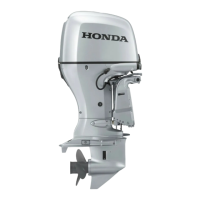Operation of the outboard
motor at an altitude lower than
the carburetor is jetted for may
result in reduced performance,
overheating, and serious
engine damage caused by an
excessively lean air/fuel
mixture.
98
High Altitude Operation
Excessive tilt angle during
operation can cause the propeller
to raise out of the water and cause
propeller cavitation and engine
over-revving. Excessive tilt angle
can also damage the water pump
and overheat the engine.
Cruising in Shallows
OPERATION
At high altitude, the standard
carburetor fuel/air mixture will be
excessively rich. Performance will
decrease, and fuel consumption will
increase.
Even with suitable carburetor jetting,
engine horsepower will decrease
approximately 3.5 % for each 300 m
(1,000 foot) increase in altitude. The
effect of altitude on the horsepower
will be greater than this if no
carburetor modification is made.
High altitude performance can be
improved by specific modifications
to the carburetor. If you always
operate the outboard motor at
altitudes higher than 1,500 m (5,000
feet) above sea level, have your
authorized Honda dealer perform
these carburetor modifications.
Monitor the cooling system indicator
for water discharge. Be sure that the
outboard motor is not tilted so high
that the water intakes are out of the
water.
If an excessive amount of throttle is
used when operating in forward gear,
the outboard motor will return to the
transom angle adjusting rod. (G type)
When operating in shallow water, tilt
the outboard motor up to prevent the
propeller and gear case from hitting
the bottom (refer to pages , ,
, and ). With the outboard
motor tilted up, operate the outboard
motor at low speed.
90
8584
86 87
11/09/05 18:12:07 32ZY0620_098

